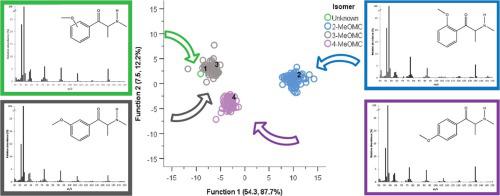Forensic Chemistry ( IF 2.7 ) Pub Date : 2021-08-24 , DOI: 10.1016/j.forc.2021.100349 Ruby E. Liliedahl 1 , J. Tyler Davidson 1

|
The emergence of highly similar compounds, such as synthetic cathinone constitutional and positional isomers, has created a growing need for the expansion of the standard analytical approaches used in forensic laboratories. This research develops a canonical discriminant analysis (CDA) approach for the differentiation of synthetic cathinone isomers using gas chromatography-electron ionization-mass spectrometry (GC-EI-MS). This study also investigates the use of multiple scans across the chromatographic peak and a reduction in the number of ions used to construct the CDA models to reduce the required number of replicate sample injections. The chloroethcathinone (CEC) and methoxymethcathinone (MeOMC) positional isomers, as well as the constitutional isomers dibutylone, eutylone, pentylone, and the positional isomer 2,3-pentylone were analyzed in this study.
The CDA leave-one-out cross-validation (LOOCV) classification rates were 90.2% for the CEC isomers and 100.0% for the MeOMC and constitutional isomer sets when 15 ions and peak apex data were used to construct the CDA models. The reduction strategies resulted in LOOCV classification rates of at least 67.9%, 98.0%, and 98.1%, for the CEC, MeOMC, and constitutional isomers, respectively. The classification rates improved for all three isomer sets to 75.3%, 99.3%, and 99.4%, respectively, when the lowest concentration samples were removed from the reduction strategies dataset. Finally, a comparison of ion selection methods revealed that the CDA classification rates were similar between the most abundant ions and the ions with the highest principal component analysis (PCA) loadings, indicating the applicability of using relative ion abundance as an ion selection method for CDA classification.
中文翻译:

使用 GC-EI-MS 和多变量分析区分合成卡西酮异构体
高度相似的化合物(例如合成卡西酮结构异构体和位置异构体)的出现,对扩展法医实验室使用的标准分析方法产生了日益增长的需求。本研究开发了一种典型判别分析 (CDA) 方法,用于使用气相色谱-电子电离-质谱 (GC-EI-MS) 来区分合成卡西酮异构体。本研究还调查了跨色谱峰的多次扫描的使用以及用于构建 CDA 模型的离子数量的减少,以减少所需的重复进样次数。氯乙卡西酮 (CEC) 和甲氧基甲卡西酮 (MeOMC) 位置异构体,以及结构异构体二丁酮、丁酮、戊酮和位置异构体 2,
当使用 15 个离子和峰顶点数据构建 CDA 模型时,CEC 异构体的 CDA 留一法交叉验证 (LOOCV) 分类率为 90.2%,MeOMC 和结构异构体组的 CDA 分类率为 100.0%。减少策略导致 CEC、MeOMC 和结构异构体的 LOOCV 分类率分别至少为 67.9%、98.0% 和 98.1%。当从还原策略数据集中删除最低浓度样本时,所有三个异构体组的分类率分别提高到 75.3%、99.3% 和 99.4%。最后,离子选择方法的比较表明,丰度最高的离子和主成分分析 (PCA) 负载最高的离子之间的 CDA 分类率相似,


























 京公网安备 11010802027423号
京公网安备 11010802027423号